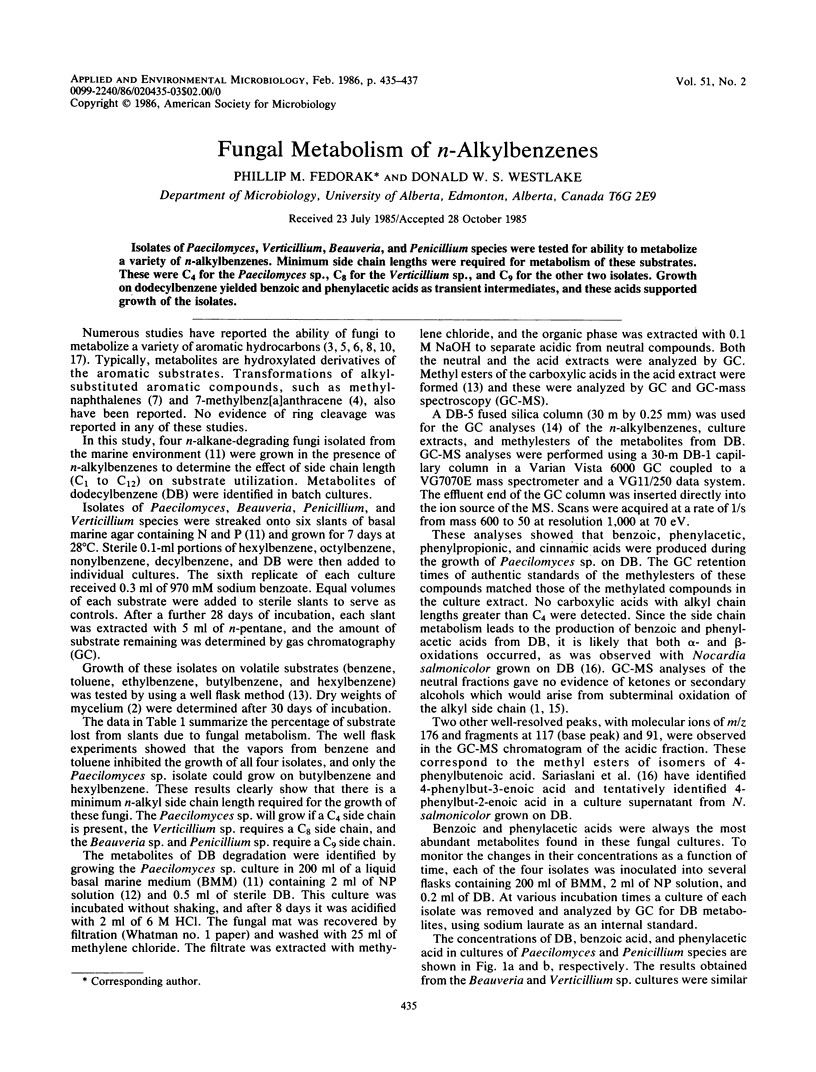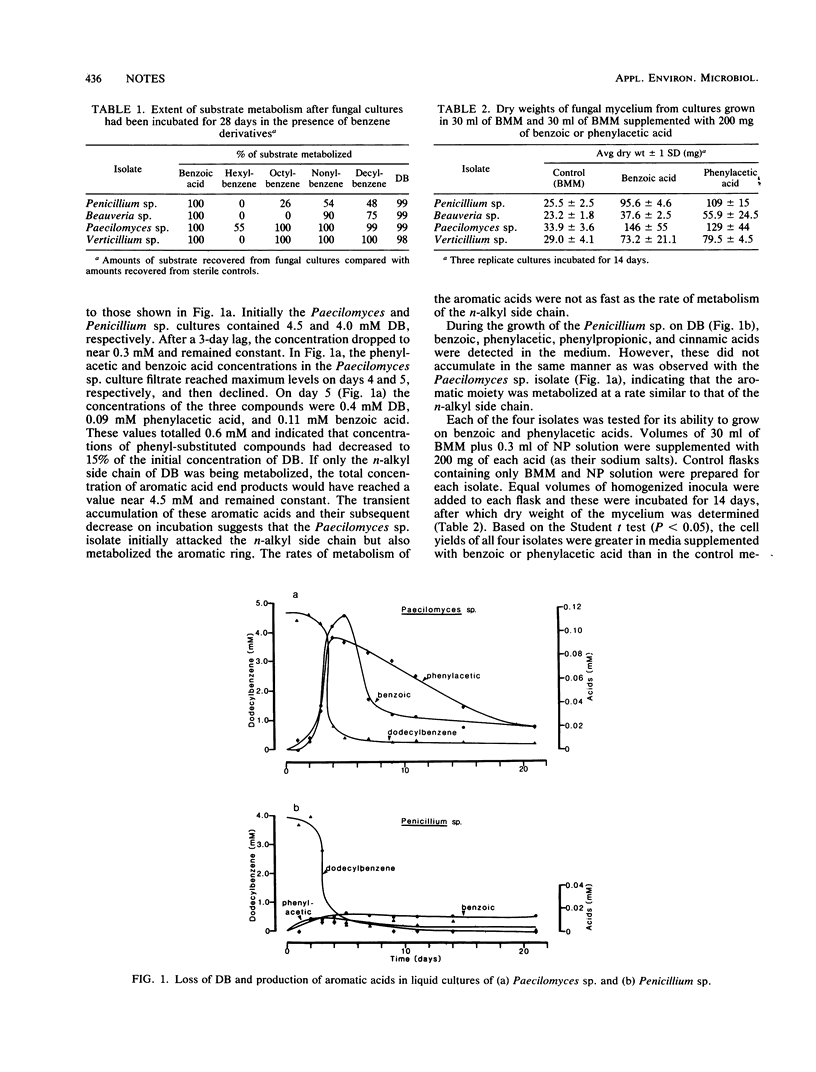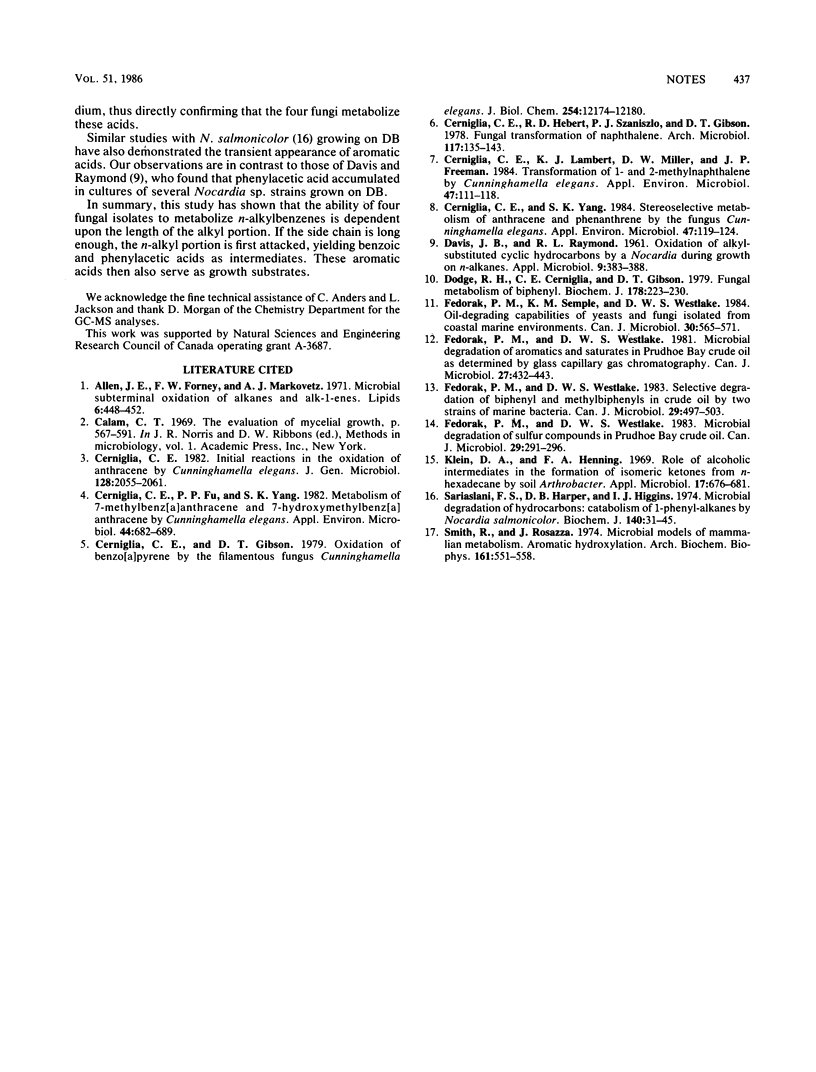Abstract
Isolates of Paecilomyces, Verticillium, Beauveria, and Penicillium species were tested for ability to metabolize a variety of n-alkylbenzenes. Minimum side chain lengths were required for metabolism of these substrates. These were C4 for the Paecilomyces sp., C8 for the Verticillium sp., and C9 for the other two isolates. Growth on dodecylbenzene yielded benzoic and phenylacetic acids as transient intermediates, and these acids supported growth of the isolates.
Full text
PDF


Selected References
These references are in PubMed. This may not be the complete list of references from this article.
- Allen J. E., Forney F. W., Markovetz A. J. Microbial subterminal oxidation of alkanes and alk-1-enes. Lipids. 1971 Jul;6(7):448–452. doi: 10.1007/BF02531227. [DOI] [PubMed] [Google Scholar]
- Cerniglia C. E., Fu P. P., Yang S. K. Metabolism of 7-methylbenz[a]anthracene and 7-hydroxymethylbenz[a]anthracene by Cunninghamella elegans. Appl Environ Microbiol. 1982 Sep;44(3):682–689. doi: 10.1128/aem.44.3.682-689.1982. [DOI] [PMC free article] [PubMed] [Google Scholar]
- Cerniglia C. E., Gibson D. T. Oxidation of benzo[a]pyrene by the filamentous fungus Cunninghamella elegans. J Biol Chem. 1979 Dec 10;254(23):12174–12180. [PubMed] [Google Scholar]
- Cerniglia C. E., Hebert R. L., Szaniszlo P. J., Gibson D. T. Fungal transformation of naphthalene. Arch Microbiol. 1978 May 30;117(2):135–143. doi: 10.1007/BF00402301. [DOI] [PubMed] [Google Scholar]
- Cerniglia C. E., Lambert K. J., Miller D. W., Freeman J. P. Transformation of 1- and 2-methylnaphthalene by Cunninghamella elegans. Appl Environ Microbiol. 1984 Jan;47(1):111–118. doi: 10.1128/aem.47.1.111-118.1984. [DOI] [PMC free article] [PubMed] [Google Scholar]
- Cerniglia C. E., Yang S. K. Stereoselective metabolism of anthracene and phenanthrene by the fungus Cunninghamella elegans. Appl Environ Microbiol. 1984 Jan;47(1):119–124. doi: 10.1128/aem.47.1.119-124.1984. [DOI] [PMC free article] [PubMed] [Google Scholar]
- DAVIS J. B., RAYMOND R. L. Oxidation of alkyl-substituted cyclic hydrocarbons by a Nocardia during growth on n-alkanes. Appl Microbiol. 1961 Sep;9:383–388. doi: 10.1128/am.9.5.383-388.1961. [DOI] [PMC free article] [PubMed] [Google Scholar]
- Dodge R. H., Cerniglia C. E., Gibson D. T. Fungal metabolism of biphenyl. Biochem J. 1979 Jan 15;178(1):223–230. doi: 10.1042/bj1780223. [DOI] [PMC free article] [PubMed] [Google Scholar]
- Fedorak P. M., Westlake D. W. Microbial degradation of aromatics and saturates in Prudhoe Bay crude oil as determined by glass capillary gas chromatography. Can J Microbiol. 1981 Apr;27(4):432–443. doi: 10.1139/m81-066. [DOI] [PubMed] [Google Scholar]
- Klein D. A., Henning F. A. Role of alcoholic intermediates in formation of isomeric ketones from n-hexadecane by a soil Arthrobacter. Appl Microbiol. 1969 May;17(5):676–681. doi: 10.1128/am.17.5.676-681.1969. [DOI] [PMC free article] [PubMed] [Google Scholar]
- Sariaslani F. S., Harper D. B., Higgins I. J. Microbial degradation of hydrocarbons. Catabolism of 1-phenylalkanes by Nocardia salmonicolor. Biochem J. 1974 Apr;140(1):31–45. doi: 10.1042/bj1400031. [DOI] [PMC free article] [PubMed] [Google Scholar]
- Smith R. V., Rosazza J. P. Microbial models of mammalian metabolism. Aromatic hydroxylation. Arch Biochem Biophys. 1974 Apr 2;161(2):551–558. doi: 10.1016/0003-9861(74)90338-5. [DOI] [PubMed] [Google Scholar]


